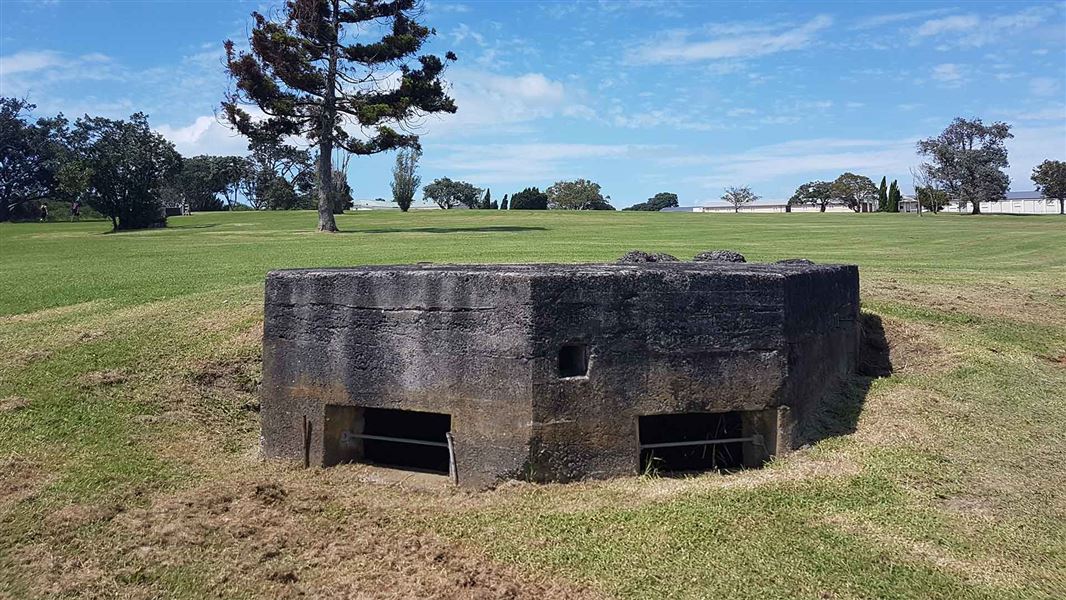
Introduction
The historic structures at Fort Takapuna Historic Reserve contain elements from all periods of coastal defence in New Zealand.The grounds of Fort Takapuna is on a commanding position at the head of the Rangitoto Channel in the Hauraki Gulf. This made it an important lookout and defence site for hundreds of years, first for early Maori inhabitants and later for European settlers.
The area has been known by a number of names over the years: Fort Cautley, HMNZS Tamaki, and Narrow Neck. The original military title for the area is ‘Fort Takapuna’, named for the point on which it stands.
Features of the fort included twin six-inch disappearing guns, an underground magazine, barracks, observation posts, and engine room and searchlights.
Conservation
Fort Takapuna Historic Reserve, one of the most significant new additions to the conservation estate, was opened by the Minister of Conservation Sandra Lee on 18 June 2000.
This was the result of a decision to classify part of the land used by the NZ Defence Forces for over a century as a Historic Reserve, and a further area as a Recreation Reserve.
Military history
The structures situated on this site form a unique historic complex containing elements from all periods of coastal defence in New Zealand. The old fort, the last of the New Zealand designed twin 6 inch gun forts, was designed by Major Tudor-Boddam of the Royal Artillery and built between 1886 and 1889.
Chain of defences
At the time Russia appeared to be threatening war with the British Empire. There were three other forts: one at Fort Kelburn in Wellington, demolished in the1960s; Central Battery – Ocean Beach Dunedin, demolished in the 1950s; and another at Bastion Point which was converted into a mausoleum for M. J. Savage.
Fort Takapuna was part of a chain of new defences around Auckland harbour. Other forts were built at North Head, Bastion Point, Point Resolution (above the Parnell Baths), and later in 1899 on Mount Victoria. This fort housed two 6 inch disappearing guns which controlled the approaches to the Rangitoto Channel. These guns were mounted in the two circular gun pits in the underground part of the fort.
At this time there were no roofs on these pits. Two smaller Nordenfelt guns, an early form of quick firing gun, were used to protect the outer flanks of the fort. The top of the iron pillar on which one of these guns was mounted can still be seen in the grass on the north-western side of the fort. (The DOC restoration programme includes preservation, repairs to historic structures and excavations to uncover buried fortifications such as these Nordenfelt gun emplacements.)
Storing ammunition
Between the gun pits there is an underground magazine for storing ammunition. On the floors of the tunnels you can still see the railway tracks on which the ammunition trolleys ran.
In the middle of the underground section there is a well which provided water for the fort. Outside in the defensive ditch a barracks was built to house the soldiers. This is the brick building with the castellated roof. By 1922 the fort’s armament was obsolete and the guns were removed from the gun pits and left outside until they were taken by a scrap merchant in 1959.
In 1926/27 the old fort was converted into a storage area for naval ammunition. The gun pits were roofed and the building next to the old barracks constructed as part of the magazine complex.
The concrete slide on the south eastern side of the ditch was built as part of the tramway used to move the ammunition around. The magazines next to the road by the playing fields were also built at this time. The fort was the main naval munitions store until 1937, when the Kauri Point magazine complex was built.
At this time there were 172 tons of ammunition stored in the old fort. The engine room is the underground building with a small courtyard on the south-western point of the Head. This room and the searchlight on the point were built in 1899.
The engine room
The engine room housed a steam engine and dynamo to provide power for the searchlights. One searchlight is situated down the tunnel on the right-hand side of the courtyard and there is another to the west accessed from a 66m long tunnel at the back of the engine room. At present this is blocked off. The searchlights were used from 1899 until the end of World War II. This engine room is in the best state of preservation of any of these structures anywhere in the country.
Guns
The three white concrete structures on the cliff top were part of the 4 inch ‘Examination Battery’ first established in 1938, which was used to control the anchorage where ships entering the harbour were examined. These guns were originally from the World War I battle cruiser HMS New Zealand. Two can still be seen outside the Auckland Museum.
The Observation Post for these guns is located above the old fort. Auckland's World War II harbour defences included underwater detection devices and an anti-submarine boom (see RNZN Chart above).
Camp
In World War I the nucleus of a camp was built at Fort Takapuna, as a training area for Maori and Cook Island reinforcements.
In 1918 the camp accommodated German prisoners of war and in 1919 was used as a hospital for flu victims.
On the eve of World War II the camp was divided in two, comprising the 4 inch guns and searchlights, and the District School of Instruction. 48 new buildings were erected and roads and parade grounds formed.
In 1963 the RNZN moved its New Entry Training School HMNZS TAMAKI from Motuihe Island to the fort. The navy built a new Gunnery School and set up an Officer Training School. Previously officers had been sent overseas for training. Today only the Officer and Trade Training schools remain.